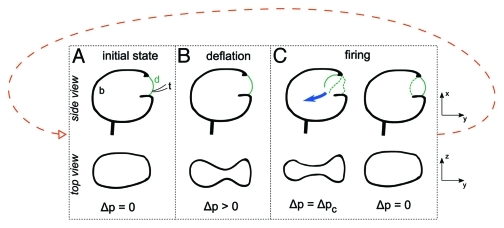Figure 2.
Simplified scheme of the different stages of trap setting and firing. In the initial state (A), the trap is fully inflated and no pressure difference exist between the interior and exterior of the trap body. Pumping of water deflates the trap (mainly in the z direction) and creates a pressure difference ∆p (B). In the buckling scenario, when ∆p exceeds a critical value ∆pc , the trap door undergoes a buckling instability enabling its opening and closure (C). Dashed lines indicate earlier positions of the door. As soon as the door is closed, the cycle starts again. On the first panel, the trap body (B), door (d) and trigger hairs (t) are indicated. For clarity, the trigger hairs are not drawn on the other panels.

